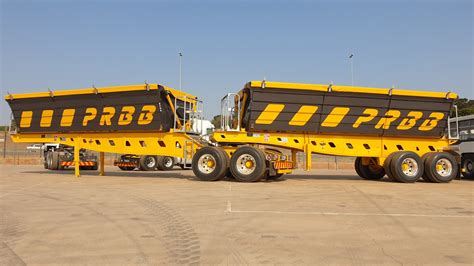
How about tipper truck trailer?
-
Introduction
-
What is a Tipper?
-
Understanding Payload Capacity
-
Factors Affecting the Payload Capacity of a Tipper
-
Types of Tippers
-
Conclusion
Tippers, also known as dump trucks, are heavy-duty vehicles designed to transport and unload bulk materials such as sand, gravel, construction waste, and mining products. They are commonly used in construction sites, mines, and quarries due to their ability to carry large amounts of material at once. The weight capacity of a tipper depends on several factors, such as engine power, suspension system, chassis strength, and legal regulations.
Panda Mech
We supply dump trailer china, chassis trailer for sale, tipper trailer for sale.
A tipper is a vehicle with a hydraulic mechanism that allows the rear platform to tilt upwards, which helps to unload the cargo. The cargo area of the vehicle is called the bed or body, and it can be made of various materials such as steel, aluminum, or fiberglass. Tippers come in various sizes and configurations to accommodate different types of loads and terrains.
The payload capacity of a tipper is the maximum weight of material it can carry, which includes the weight of the body, the chassis, the engine, and the driver. The payload capacity is determined by subtracting the vehicle’s curb weight (weight of the vehicle without any load) from the Gross Vehicle Weight Rating (GVWR), which is the maximum weight allowed for the vehicle as per legal regulations.
The following factors can affect the payload capacity of a tipper:
– Engine Power and Torque
The engine power and torque determine the pulling power of the vehicle and its ability to carry heavy loads. Tippers with higher engine power and torque can carry more weight than those with lower power.
– Chassis Strength and Durability
The chassis of a tipper should be strong and durable enough to support the weight of the body and the cargo. Tippers with heavier and stronger chassis can carry more weight than those with lighter and weaker chassis.
– Suspension System
The suspension system of a tipper plays a crucial role in determining its payload capacity. Tippers with better suspension can carry heavier loads without compromising stability and safety.
– Tyres
The type and size of tyres used in a tipper can affect its payload capacity. Tippers with larger and stronger tyres can carry more weight than those with smaller and weaker tyres.
– Body Type and Size
The type and size of the body of a tipper can also affect its payload capacity. Tippers with larger bodies can carry more weight than those with smaller bodies, and tippers with specialized bodies (such as side-tippers) can carry specific types of material more efficiently.
– Legal Regulations
The payload capacity of a tipper is also limited by legal regulations, which vary depending on the country and the type of vehicle. Overloading a tipper can result in fines, penalties, and even suspension of the vehicle’s registration, as it poses a risk to road safety.
There are several types of tippers available in the market, each designed for specific purposes and load capacities. Some of the most common types include:
– Standard Tipper
This is the most basic type of tipper, with a hydraulic system that tilts the bed to unload the cargo. It can carry up to 20 tons of weight and is commonly used in construction sites.
– Semi-Trailer Tipper
A semi-trailer tipper is a combination of a truck and a trailer, with a detachable body that can be lifted by the hydraulic system. It can carry up to 40 tons of weight and is commonly used in mining and quarrying.
– Truck and Dog Tipper
A truck and dog tipper is a combination of a truck and a trailer, with a shorter trailer attached to the rear of the truck. It can carry up to 25 tons of weight and is commonly used in road construction.
– B-Trains
A B-train is a type of semi-trailer tipper with an additional trailer attached to the rear of the first trailer. It can carry up to 70 tons of weight and is commonly used in long-haul transportation.
In conclusion, the weight capacity of a tipper depends on various factors such as engine power, suspension system, body type, and legal regulations. It is essential to ensure that the payload capacity of the tipper is within the legal limits to avoid penalties and ensure road safety. Understanding the different types of tippers available in the market can help choose the right vehicle for specific purposes and load capacities.
FAQs
What is the maximum weight a tipper can carry?
The maximum weight a tipper can carry depends on various factors such as engine power, chassis strength, and legal regulations. It can range from 20 to 70 tons.
Can tippers be used to transport liquid materials?
Yes, tippers can be used to transport liquid materials such as water, oil, and chemicals, with the use of specialized bodies such as tankers.
Are there any legal restrictions on the weight capacity of tippers?
Yes, there are legal restrictions on the weight capacity of tippers, which vary depending on the country and the type of vehicle. Overloading can result in fines, penalties, and suspension of the vehicle’s registration.
What is the difference between a standard tipper and a semi-trailer tipper?
A standard tipper is a single unit vehicle with a hydraulic system that tilts the bed to unload the cargo. A semi-trailer tipper is a combination of a truck and a detachable trailer with a hydraulic system that lifts the body to unload the cargo.
What type of tipper is best for mining operations?
A semi-trailer tipper is commonly used in mining operations, as it can carry heavy loads and maneuver in rough terrains.







